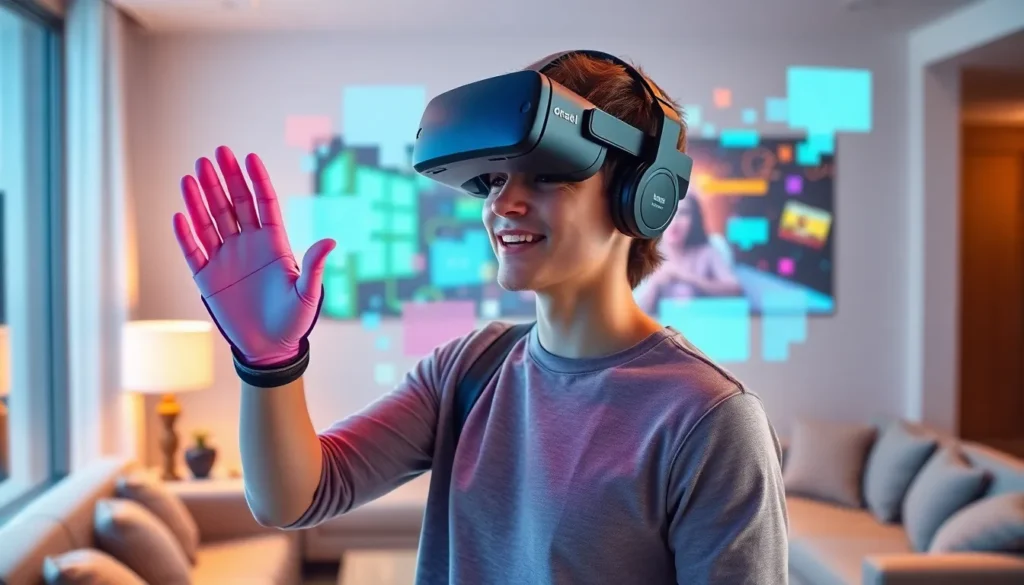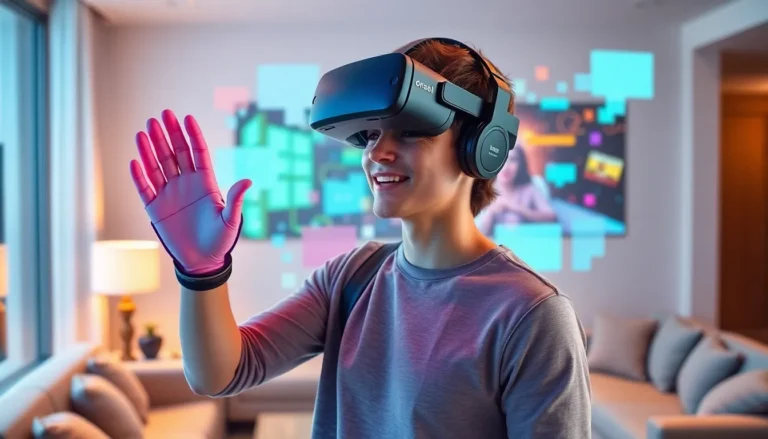Table of Contents
ToggleIn a world where laptops have become extensions of ourselves, diving into laptop research is like embarking on a digital treasure hunt. With countless options out there, finding the right one can feel like searching for a needle in a haystack—if that needle had a thousand different models and specs. Whether it’s for work, play, or binge-watching cat videos, the right laptop can make all the difference.
Overview of Laptop Research
Laptop research involves analyzing various factors to identify the right device for individual needs. Specifications such as processor speed, RAM, storage capacity, and graphics card type play crucial roles in performance. Understanding each component aids in making informed decisions.
Pricing also varies significantly among models. High-end laptops targeting gamers often cost more due to advanced graphics and faster processors. Budget options exist, offering essential features without extra costs. Researching price trends helps users secure the best deals.
Brand reputation should not be overlooked. Established companies often provide reliable warranties and customer service. Newer brands might offer impressive specifications at competitive prices, attracting those focused on value.
Performance tests and reviews provide insights into real-world usage. Users benefit from checking benchmark scores to understand how a laptop performs under different conditions. User reviews often highlight day-to-day experiences, offering additional context beyond technical specifications.
Portability and battery life are essential for users who travel frequently. Lightweight models and those boasting long battery life fit active lifestyles better. Assessing these aspects in research ensures that the chosen laptop meets mobility demands.
Compatibility with software also matters. Users engaged in specific fields should verify that their preferred applications run smoothly on potential devices. Operating system considerations, such as Windows or macOS, influence user experience and software availability.
By thoroughly researching these factors, individuals can navigate the complex laptop market more effectively, ensuring a well-informed purchase. Results from research directly impact the satisfaction and performance of the chosen device, making this process vital for anyone in the market for a new laptop.
Trends in Laptop Technology

Laptop technology continues to evolve rapidly, driven by consumer demands for better performance and portability. Current trends focus on slimmer designs and higher performance metrics.
Evolution of Laptop Designs
Designs have transformed from bulky units to sleek, lightweight models. Ultrabooks now dominate the market with thin profiles, weighing around three pounds or less. Manufacturers use materials like aluminum and carbon fiber to enhance durability while maintaining lightweight characteristics. Convertible laptops, which transition between tablet and laptop modes, offer added versatility for users. A growing preference for minimal bezels supports a more immersive display experience, allowing for larger screens in compact sizes.
Emerging Technologies in Laptops
Emerging technologies redefine laptop performance and usability. Innovations like artificial intelligence enhance user experiences through predictive computing. Some laptops now feature solid-state drives with read speeds exceeding 5000 MB/s, significantly improving data access times. Display technology also advances with OLED screens, offering vibrant colors and deeper contrasts, appealing to creative professionals and gamers. Furthermore, integrated graphics solutions deliver sufficient power for casual gaming without the need for separate graphics cards. Battery technology is evolving, too, with some models achieving up to 20 hours of life on a single charge, catering to on-the-go users.
Key Areas of Laptop Research
Laptop research focuses on several crucial areas that influence buying decisions. Understanding these core elements aids in navigating choices effectively.
Performance Optimization
Processor speed significantly impacts laptop performance. High-end models commonly feature multi-core processors, enabling seamless multitasking. RAM capacity also plays a pivotal role; 16GB generally meets the needs of gamers and professionals alike. Meanwhile, graphics cards determine how well laptops handle visual tasks. Discrete GPUs are preferred for gaming and design work, while integrated options suffice for everyday usage. Furthermore, evaluating benchmarks from trusted sources can provide real-world performance insights.
Battery Life Innovations
Battery life has seen notable improvements, with many modern laptops boasting up to 20 hours per charge. Manufacturers employ advanced battery technology to extend usage between charges. Lightweight designs often complement these innovations, making laptops more portable for users on the go. Fast charging capabilities also contribute to convenience, allowing users to gain hours of productivity from short charging sessions. Selecting models with higher energy efficiency ratings ensures longer battery life during daily tasks.
Display Technology Advancements
Display technology contributes significantly to overall user experience. Today’s laptops often utilize IPS and OLED screens that offer vibrant colors and wider viewing angles. Many models feature resolutions that exceed Full HD, such as 4K, enhancing detail for gaming and media consumption. Additionally, screen brightness and adaptive refresh rates enhance usability in various lighting conditions. Users increasingly prioritize touch capabilities, combining functionality with intuitive navigation. Evaluating these advancements can guide potential buyers toward displays that meet their specific needs.
Research Methodologies in Laptop Studies
Laptop research utilizes various methodologies to arrive at data-driven conclusions. Qualitative research often involves user interviews or focus groups that gather personal experiences about laptop performance and usability. Quantitative methods rely on surveys or experiments measuring specific attributes, such as battery life and processing speed.
Comparative analysis plays a vital role in evaluating different laptop models. Researchers examine multiple configurations to assess how specifications impact performance. Benchmark tests offer insights into processing power by running standard software tasks, providing measurable data on speed and efficiency.
User reviews collected from multiple platforms supplement formal studies. Analyzing a broad range of feedback helps identify common strengths and weaknesses among various brands. These insights reveal trends in user satisfaction and potential issues that may affect purchasing decisions.
Case studies provide deeper understanding in specific contexts. By exploring particular cases such as gaming laptops or business models, researchers can highlight unique requirements and preferences. Contextual factors, including price points and target audiences, shape the results and conclusions drawn from such studies.
Longitudinal studies analyze technology trends over time. Observing laptop evolution exposes shifts in consumer priorities, such as increased emphasis on portability and battery life. Tracking these changing demands helps manufacturers align their products with market needs, ensuring relevance and competitiveness.
Surveys conducted among target demographics identify user preferences. These instruments often reveal what features consumers find most important, such as graphics capabilities or weight. Analyzing this data helps in predicting future laptop trends and guiding potential improvements.
Incorporating multiple methodologies provides a holistic view of the laptop market. Diversity in research techniques allows for comprehensive assessments of models, ensuring individuals make informed purchasing choices.
Challenges in Laptop Research
Navigating the laptop market presents several challenges. The vast array of models makes it difficult to identify the optimal choice for specific needs. Consumers face uncertainty when evaluating different specifications, as benchmarks vary based on intended use.
Identifying reliable performance data is crucial. Performance tests may not reflect real-world usage accurately, complicating the selection process. User reviews offer insights, yet these can be subjective and inconsistent among different review platforms.
Price variability compounds these difficulties. Premium laptops, especially those designed for gaming, often come with a hefty price tag. Budget-friendly options may seem appealing, but they might lack essential features needed for demanding tasks.
Compatibility issues arise with varying software requirements. Certain professions necessitate specific applications that demand higher processing power or graphics capabilities. Understanding these requirements impacts purchasing decisions significantly.
Another challenge involves battery life and portability. While some models advertise extended battery life, real-world performance may tell a different story. Frequent travelers require lightweight designs to enhance mobility without sacrificing power.
Moreover, keeping up with rapid technological advancements poses a challenge. Innovations in battery technology and display options emerge regularly, creating confusion in the decision-making process. To streamline choices, prioritizing factors like processor speed, RAM, and display technology helps potential buyers narrow down selections.
Evaluating a laptop’s long-term value also warrants attention. Many consumers may overlook warranty conditions or customer service reputation, which play a significant role in user satisfaction. Through a thorough research approach, individuals can mitigate these challenges and make informed decisions in their laptop search.
Navigating the laptop market requires a strategic approach. With numerous options available it’s essential to prioritize individual needs and preferences. The right laptop can significantly enhance productivity and leisure experiences.
By focusing on performance metrics battery life and design features consumers can make informed choices that align with their lifestyle. Staying updated on technological advancements ensures that buyers select devices that not only meet current demands but also adapt to future needs.
Thorough research and consideration of user experiences will lead to a satisfying purchase. With the right tools and knowledge anyone can uncover their ideal laptop in this vast digital landscape.







